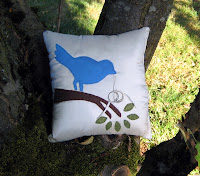Part 3 of ideas for 2-D to 3-D lessons
My new school still has a shop/industrial arts class (isn't that amazing!) so I'm hoping to scavenge some scrap wood to use as a base on the classic coat hanger, stocking, and house paint sculpture. These sculptures are sure fun to make and the overall shapes are almost always interesting. However, I find that painting them to be the least successful aspect. We have tried painting the sculptures with one pattern all over or with variegating color or while trying to chase the "planes" of a very mesomorphs shape. The end result is very hit or miss.

Now I have two new ideas to try. First off...and I don't know where I saw it, but someone had their student's paint their sculpture with aboriginal dot designs which was really cool.
Second, I remember one of my supervising teachers having talked about this idea but never saw a sample but I found a few examples on this site. What a cool idea...making the sculpture into a Picasso/cubist style face.

Picasso faces and
stocking and wire hanger face sculptures from Waunakee Middle School (so many great ideas!)
Also I think it's a good idea to pause after you have just painted the sculpture white and trying to do some value/shade study drawings before you add color to the project.
On the 2-D side there are unlimited lessons for Picasso/cubist face lessons...from the simple to the very complex.
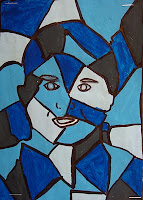 here are some great examples from Hannah at Art.Paper.Scissors.Glue! (great thoughts her way as she is taking on 7th graders for the first time this year:) )
here are some great examples from Hannah at Art.Paper.Scissors.Glue! (great thoughts her way as she is taking on 7th graders for the first time this year:) )
We will see if this new batch of kids resists doing anything with their photo as much as my past students. If so we usually do a similar project but with animals instead.

Speaking of animals I love any project that allows students to choose their own animal to make art about. Animal, fish, reptile, bird...whatever. Now whenever you are talking animals it is a great time to talk texture. Of course we can use shading to create implied texture or we can tap our inner 2nd grader and make a ton of textured papers to make Eric Carle style animal collages.
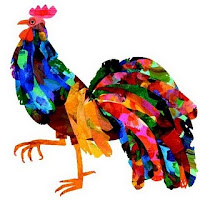
Before you poo poo this as too juvenile for middle school or even high school students think twice. Real problem solving work goes into breaking a large image into smaller shapes.
I require at least five papers to be used in the collage and each animal needs to be broken down into at least 5 sections...fantasy colored animals are fine and you need to go back and work some oil pastel into the finished product.
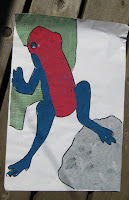
not done yet....but a great start!
And onto the 3-D. Due to my kiln limitation I haven't done with in years but my good friend, who happens to be an excellent art teacher and guest teacher extraordinaire, tackled this lesson with some young men and women this summer. Look at their amazing results.


she suggest using acrylic paint instead of glaze and a modified wash method which I think is a great idea and allows students to control color, detail and eliminates some of the risk that goes with double firing and glaze firing a thin tile. (A- if you want me to link to your blog or put your name let me know...trying to protect your privacy unless you ask otherwise:) )
Warping things up with today's 2 to 3-D ideas lets take a look at a lesson often referred to as "Common threads."
I've seen this lesson done by several teachers but I think I have tracked the original idea to Bunki Kramer of Los Cerros MS. I don't know if she still teachers, but there are amazing lessons on her school website.
some images of HER student's amazing work on the original lesson

I know it is a little fuzzy but do you see how the ribbon goes between and around each students hand/fingers and connects to the next student's drawing? The ribbon links all the students drawings and then she made a copy of each students drawing for everyone in the class and they assembled them into books with everyone's hands. Pretty cool!.
So I have done this lesson 3 times now. Sometimes in black and white and sometimes in color. I almost always let the kids do the hand shading with pencil so they can erase.
Sophie Wagner Max back at Waunakee Middle School again has students use textiles from around the world to inspire their backgrounds.

(click to enlarge)
Size matters with these. If you use to large of paper the kids get board with making the background textures and poop out. I suggest sticking to copy or 11"x14" size paper.
I once got a bag of fancy scrapbook paper scraps and had students choose 3 and glue them into the background and then continue the design in colored pencil. I liked this method because it brought color into the work and reduced the amount of background drawing the kids needed to to.
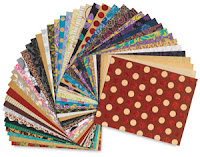
I've been using a $10 pack of these papers for this lesson and book making for 5 years now. Good investment.
Of course you can also do contour line drawings of hands spelling a word in sign language...students like learning and drawing the finger spelling but I'm still working on how to get a nice background or boarder around the hands.
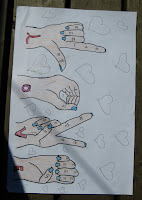
Why does blogger do this rotating thing sometimes!!!!!???
For the 3-D part we are gonna plaster cast our hands! But it's so expensive you say! About $2 to $3 per kid depending on where you get the plaster. Less if you plan ahead and work those Jo-anns and Michelle's coupons.

I've always used Activa Rigid Wrap along with lots of Vaseline and have had no problems. Word on the street is that you can get plaster cast strips from medical supply places and that might be cheaper. I need to look into it.
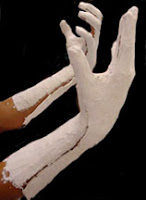
(NOTE) Casting one side of the hand and stopping at the wrist is enough and keeps the kids from getting stuck in the plaster. DO NOT stick a kid's hand into a bucket of plaster of Paris!
This is the only time that I ask students to kick in some $. Without fail, even at my 87% free and reduced lunch school, if I give students enough warning they can scrape together a few dollars. I find parents are willing to contribute for this lesson because it permanently captures their child's hand during the adolescent years when they are no longer getting hand print mother's day plaques.
I send a note home explaining the lesson, requiring a parent signature saying its ok to cast their kid's hand and asking for a $1 -$3 to help off-set the cost. No parent permission slip no casting. No exceptions. We cast over two days so if you forgot day one you can help someone else cast their hand and you have a chance to get the permission slip in for the second day.
 Nice work! Done by HS level student over at A faithful attempt
Nice work! Done by HS level student over at A faithful attempt
How to decorate? That's the fun and the trick. Like the coat hanger/stocking sculptures these can go downhill during the painting process. When casting the hand remind the students repeatedly to smooth the plasters to they have a smooth surface to paint on later. Make sure students have a drawn out plan before they start to paint. I've started to require a simple symbol or image be incorporated into the design. It would be great to take one of the patterns from the common threads background and paint the hand that way. Animal prints work well sometimes...if done well. Some students have painted mendi like designs that take time and and a paint pen but look nice.
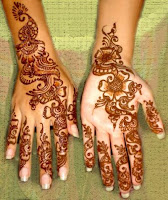
this may be a good time to break out the sharpies but make sure to let the plaster cure (dry) for a few days before you paint. Our other favorite use for this project is to "mummify" our hands at the end of our Egyptian unit and then paint a single Egyptian symbol, one hieroglyphic or an entire name in hieroglyphics.
There you go...on a A/B day schedule I think I've now posted enough lessons to go an entire semester if not more. Still looking for your favorite way to go from 2-D to 3-D. Up next....How to make large 3-D cardboard letters.


 heheh! from Inner City Snail....a awesome artist/ art movement
heheh! from Inner City Snail....a awesome artist/ art movement
 BLOGGER WHY WHY DO YOU DO THIS!!!!
BLOGGER WHY WHY DO YOU DO THIS!!!!
 oh I give up with the photos and the rotating and such.
oh I give up with the photos and the rotating and such.









